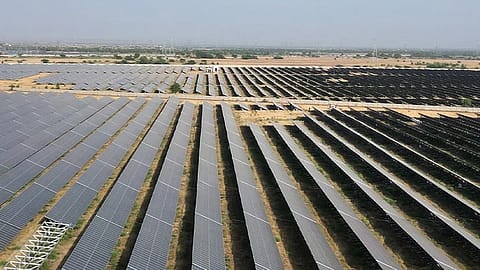Independence 2.0: India’s clean energy future is its strongest trade defence
The tariffs are a wake-up call. They are a reminder that in a world of trade wars, energy insecurity, and shifting alliances, self-reliance is not merely a slogan but a survival strategy.

As India turns 78, the echoes of 1947 resonate anew. Back then, the world doubted whether this vast, diverse nation could survive, let alone thrive. Today, amid escalating tariffs from the U.S. aimed at controlling energy flows, India faces another pivotal test of resilience. History teaches that when India is pushed into a corner, it adapts and leaps forward.
The tariffs are a wake-up call. They are a reminder that in a world of trade wars, energy insecurity, and shifting alliances, self-reliance is not merely a slogan but a survival strategy. This August 15th, as we celebrate the journey from scepticism to strength, let’s recognise that true independence in the 21st century means energy independence. The only way forward is to double down on renewables and electrification, executed with the urgency and unity that characterises modern India.
Tariffs and a new tryst with destiny
India’s big solar push over the last decade has laid the groundwork. From just 4 gigawatts (GW) of solar in 2014 to over 100 GW today, alongside 50 GW of wind, India is starting to build an enviable home-grown clean power market.
These are not just statistics. They are the foundation for a sustainable economic future, one where India’s energy security is insulated from the caprices of foreign governments and the volatility of fossil fuel markets.
This is not just about adding megawatts; it’s about building a megasystem that fuels a billion dreams. It’s about forging a genuinely home-grown market for renewable power, with Indian companies, engineers, and innovators at its heart. Yes, there are issues. But, by luck or by design, India is well-positioned to embark on an energy revolution.
The stakes are higher now. Fragmented policy and legacy thinking, where only a handful of states lead the charge, can no longer safeguard us from global disruptions. Proactive measures are essential. India must view the U.S. tariffs as a catalyst to break free from the shackles of the past and construct a resilient, future-proof energy system that can withstand external shocks.
Recommended Stories
Winning two crucial races
To seize this moment, India must think beyond just adding solar panels or wind turbines. It has to compete and win in two races: the race to build renewables, and the race to electrify sectors that will use that clean power, such as transport, industry, and even cooking. This will reduce reliance on energy imports and raise the ceiling for what our home-grown renewable capacity can do.
Our transport sector, for example, was key in our oil import bill reaching a jaw-dropping $158 billion last year. Electrification can slash this dependence and direct our energy dollars back home. While we lead the world in electric two- and three-wheelers, four-wheelers and buses lag behind. Fragmented policymaking has stifled growth, limiting the benefits of renewables and electric vehicles (EVs) to only a few cities. The time for half-measures is over.
Batteries: The next frontier
If solar and wind are our new freedom fighters, batteries are their shield. Battery energy storage systems (BESS) are now cost-competitive with gas and coal for peak power, with battery costs having already fallen 80% in the last decade and set to halve again by 2030. India can build batteries and solar plants far faster than coal or gas plants. With the right policies, India could turbocharge its “Made in India” energy security in just a few years.
Learn from China, act like India
While easier said than done, China offers some important lessons that India can implement with adjustments. In less than two decades, China has evolved from an energy laggard to a world leader in renewables and electrification. It achieved this through coordinated, large-scale policy interventions, relentless investment in domestic manufacturing, a singular focus on grid and battery technologies, and a patient but calibrated “build before break” approach to policy implementation. China did not wait for global consensus; it seized its destiny and now dominates supply chains for solar, batteries, and EVs.
India has the same potential and perhaps a greater sense of purpose and urgency, driven by its vibrant societal dynamism and a history of overcoming adversities. However, we must act with the urgency and coordination that befits an emerging global power to address the ambitions of our young population. A unified national mission for renewables, battery storage, domestic manufacturing, and EVs must evolve into national priorities, not just policy options.
Spirit of 1947, resolve of 2025
India’s story is one of forging its destiny. The U.S. tariffs are just the latest test. The India of the 2020s cannot wait for permission to shape its future. It is imperative to shed the legacy constraints as the world shifts from globalisation to fragmentation and hedging, where self-reliance and resilience are the new watchwords. Policy inertia is no longer tenable.
The transition isn’t just strategic; it’s a catalyst for industry, jobs, and innovation. A thriving domestic battery and solar sector can create a new clean energy market, power the EV revolution, cut trade deficit, and unleash Indian ingenuity.
The forces are in our favour; now is the time to act decisively. India must now leap from incremental progress to true energy independence by making renewables and electrification the twin pillars of its 21st-century economy. The world is not waiting for us, and neither should we.
Views are personal. Lolla is Asia Programme Director at Ember, an independent energy think tank.